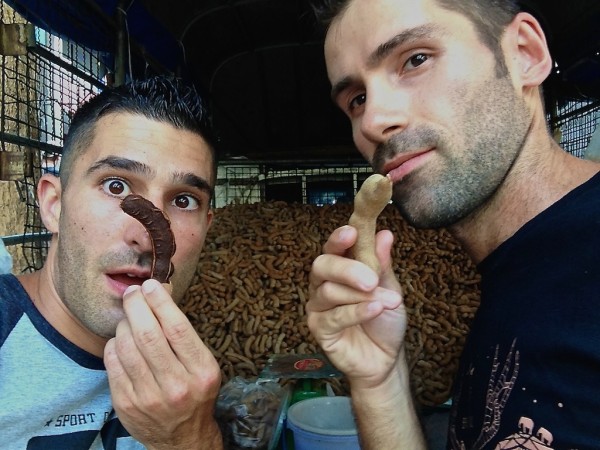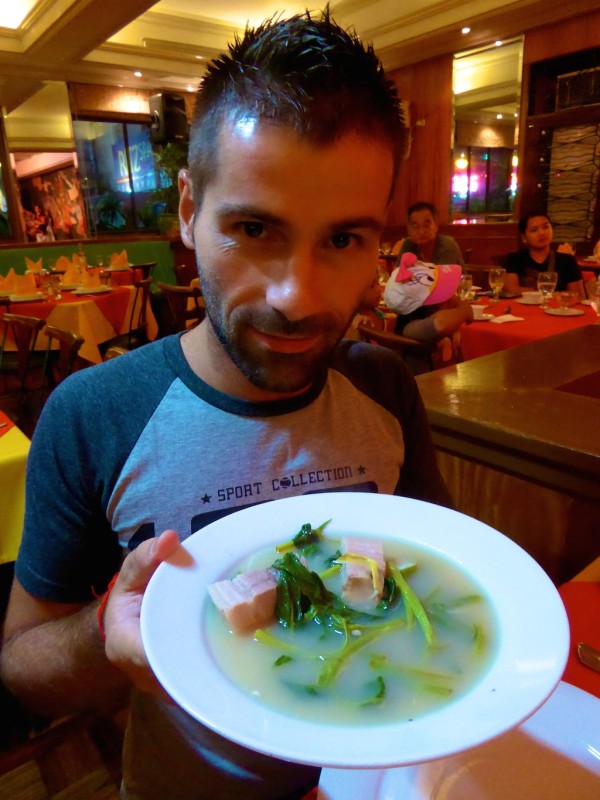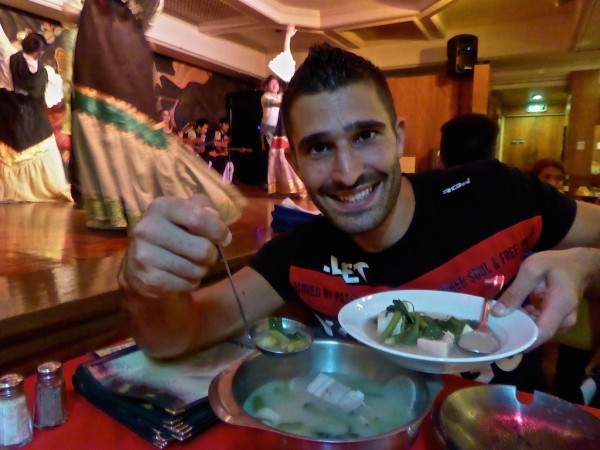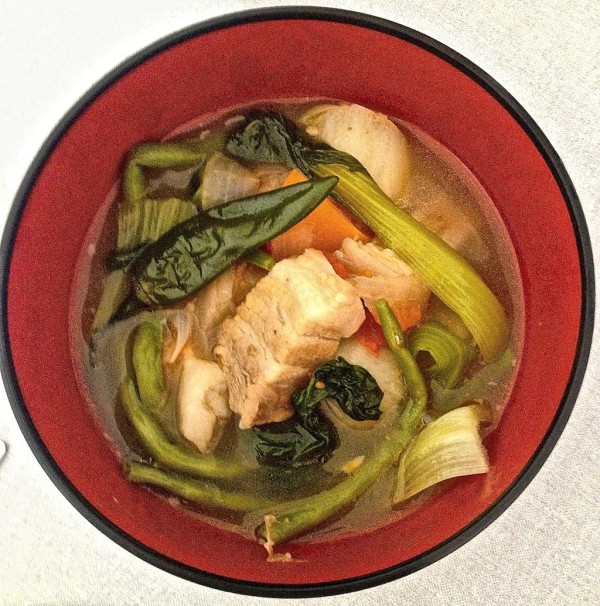In Manila we tried and loved the yummy sour pork sinigang soup.
Sinigang (‘stew’) is a meat based stew or soup broth with lots of vegetables and flavoured with a variety of souring agents like tamarind (‘sampalok’).
We loved it so much that we kidnapped our lovely Filipina friend B.C.Lee to show us how to make it and she gave us this recipe.

Kidnapping our Filipina friend BC Lee to teach us pork sinigang
“Hi Stefan and Sebastien. I am BC Lee and like you boys I love my food so much I keep a blog of my food discoveries called Wild Kitchen Rhythm.
This is my recipe for pork sinigang – a quintessential Filipino dish.
In some regions of the Philippines, people use alternative souring agents to tamarind like tomatoes, guavas, kalamansi (Filipino lime) or even kamias (‘bilimbi fruit’). However, tamarind is the most common and my favourite.

Shopping for our pork sinigang: our tamarind selfie
My recipe is for pork sinigang, but chicken, beef and fish can also be used. The tamarind mix can be bought in packets, but it tastes so much better if you make it yourself.
This recipe is enough for 3-4 persons, or an average dinner for you two greedy boys.
Ingredients for Filipino pork sinigang
- 1kg of fatty pork meat like belly or ribs (cubed)
- 3 cloves of garlic, chopped
- 1 knob of ginger, sliced thinly
- 2 onions
- 4 tomatoes
- 1 white radish
- 1 bundle of bok choi or swamp cabbage (kangkong)
- 1 bundle of long beans
- 2 eggplants
- 1 carrot (not a traditional sinigang ingredient but it adds colour to the dish)
- 2 green chillies
- 2 taro roots (gabi)
- 300g of unripe tamarind fruits
- 1 litre of water
- 2 tablespoons of fish sauce
- 2 tablespoons vegetable oil
- a pinch of salt to flavour

Sebastien proudly showing off his pork sinigang
How to make Filipino pork sinigang
1. Heat 2 tablespoons of vegetable oil in a pan and on a low heat, uncovered cook the ginger, pork, onions, and garlic for a few minutes to render the fat (liquify the fat) out of the meat.
2. Add the tomatoes and cook for a further 5 minutes – until they become mushy.
3. Add enough water to cover the meat and on a high heat, uncovered, bring it to a boil.
4. Once boiling, reduce heat to a simmer, cover and cook for 15 minutes or until the pork is tender.
5. Whilst waiting for the pork to cook, prepare the tamarind juice. Start by washing the tamarind fruits thoroughly.
6. Boil the tamarind fruits for about half an hour in a pot with 1 litre of water or until the pods have softened.
7. Take out the fruits and place them in a separate bowl with a few scoops of the tamarind water.
8. Mash the fruits in this water.
9. Strain the liquid with a sieve into another bowl to ensure you don’t get brown bits and seeds into the strained liquid.
10. You want a tart taste and a cloudy consistency. If the liquid is too thick, you can add a few tablespoons of water but be careful not to dilute it too much.
11. Add a teaspoon of salt to the mixture and set it aside for later.
12. Add the taros, carrots, radish and long beans, and cook for a further 10 minutes on a low heat, uncovered.
13. Mix in the eggplant, chillies and the bok choi or swamp cabbage and cook for a further 3 minutes.
14. Add 2 tablespoons of fish sauce, the tamarind mixture and a pinch of salt. Cook on a low heat, uncovered for 3 minutes.
Serve Filipino pork sinigang hot and with rice. A fish sauce is also sometimes served, which contains mashed chillies and kalamansi (Filipino limes).

Stefan serving Filipino pork sinigang
Travel with us as we swam our way through Boracay and Palawan in our Philippines travel video.

Amazing Megan
Sunday 4th of October 2020
There is no right and wrong way of cooking Sinigang. As long as you taste it good, it's okay. Gonna try this recipe!
Thursday 19th of January 2017
4.5
Bem
Saturday 11th of July 2015
Thanks Stefan and Sebastien! I love the fact that you're inveterate foodies like me and it's always great to exchange recipes from you. Like the adobo, Filipinos have various ways of cooking sinigang but it's still based on basic ingredients. Some people just boil the meat straight away and add the other ingredients later on. My extra process of sauteeing the meat was from my grandmother who said it's good to seal in the flavors of the meat and also to add another depth of flavor to the dish. Either way, the end result will be as good.
The sinigang version that you tried, I suspect, either used rice washing (a common ingredient in traditional sinigang cooking), which is why it has a cloudy white color... or it could be crushed gabi (taro) too. It's great with fish sauce with lots of chilies!
Sinigang, by the way, is really great to eat when it's a hot day... somehow the soup is quite refreshing... or maybe it's just me :) Keep cooking and eating you guys!
Nomadic boys
Sunday 12th of July 2015
Agreed! It's the sort of yummy dish we'd be happy to eat on a hot or cold day :)